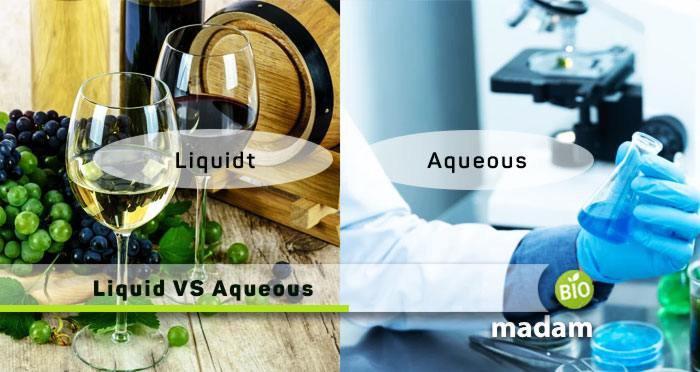While commonly referring to an aqueous solution, many people think that you are talking of just another material in a less-viscous form – a liquid! However, liquids and aqueous solutions are not entirely the same.
If you wonder, “Is liquid and aqueous the same,” let us tell you that all aqueous solutions are liquid, but all liquids are not aqueous.
We have listed down all the differences between liquid and aqueous for you to understand better.
Comparison Table
| Factor | Liquid | Aqueous |
| Definition | Incompressible fluid | Composed of water |
| Purity | In natural form | Maybe pure |
| Composition | Might not contain a solute | Contains a solute |
| Polarity | Polar or non-polar | Always polar |
| Solubility | Soluble or insoluble | Always soluble |
| Solutes | Hydrophilic/hydrophobic | Hydrophilic |
| Examples | Oil, alcohol, blood | Salt solution, rain, tea |

What is a Liquid?
The liquid is one of the three states of matter. It takes space, and has a volume, but does not retain its shape. Liquids are nearly incompressible and take the shape of the container they are poured into. Chemically, liquids could be made of numerous components and may be hydrophilic or hydrophobic. The liquid particles are tiny and are in a vibrating motion. They are held together by intermolecular forces. However, they are not strong enough to keep the substance in a particular shape.
Liquids of different kinds have their specific viscosity. Viscosity is the resistance of a liquid to flow. Water is a less viscous liquid, while honey is highly viscous. They are quite denser than gas and may be called condensed matter apart from gas.
What is an Aqueous?
Aqueous relates to anything that contains water. While liquids refer to any matter in a less compressed form than solids, without a fixed shape, aqueous solutions always have water as the solvent. Usually, the solute dissolves in water completely to produce a new compound. Water is also known as the universal solvent as it combines with almost all solutes to make an aqueous solution.
Aqueous solutions are denoted by adding “(aq.)” next to the mention of the solution. If “(aq.)” is not mentioned with a liquid, it could be without water as well. Contrasting to liquids, aqueous solutions are always polar.
What are Non-aqueous Solutions?
Solution refers to the combination of solute and solvent when the solute dissolves in the solvent completely. Aqueous solutions contain water as the solvent, yet non-aqueous solutions may contain any other solvent besides water. Alcohol and oil are common examples of non-aqueous solutions.
What is the Difference between Liquid and Solution?
Solutions and liquids are similar to each other in a way that they both are in a liquid state without any specification of the components. Liquids are mostly considered to be in their pure form, whereas solutions may be formed between liquids and solids, liquids and gases, liquids and liquids.
Difference between Liquid and Aqueous
Definition
Liquid
A liquid is defined as any substance or a mixture with a particular volume but not a definite shape.
Aqueous
Aqueous is a solution containing water as the solvent.
Characteristic
Liquid
Liquids are one of the states of matter.
Aqueous
On the other hand, aqueous are solutions with water as a solvent in which commonly a soluble solute is present.
Purity
Liquid
Liquids in their natural form are called pure liquids. If you add an impurity to it, they are known as the contaminated liquid.
Aqueous
While aqueous solutions have water with a solvent present in them.
Composition
Liquid
A liquid may or may not contain a solute.
Aqueous
On the contrary, an aqueous solution always contains a solute.
Polarity
Liquid
A liquid may be polar or non-polar.
Aqueous
But, aqueous solutions are always polar in nature.
Solubility
Liquid
The solute in a liquid may or may not be completely soluble with the solvent.
Aqueous
Whereas the solute dissolves completely, forming a third substance called a solution.
Solute
Liquid
The solutes could be hydrophilic or hydrophobic and form a mixture or substance depending on the solvent.
Aqueous
Yet, the solute in an aqueous solution is always hydrophilic.
Examples
Liquid
Common examples of liquid are blood containing RBCs and WBCs, oil, and alcohol.
Aqueous
Examples of aqueous solutions are rain, tea, and salt solution.

FAQs
Are aqueous solutions and mixtures the same?
If the solute is entirely soluble in the solvent, it makes a homogenous mixture or a solution. In contrast, mixtures (heterogenous) are those with insoluble solutes present in them.
Are acids aqueous or liquid?
It may surprise you that acids are aqueous solutions according to the Bronsted–Lowry and Arrhenius definitions. They are considered so because of their ability to dissociate in water.
What is the difference between liquid ammonia and aqueous ammonia?
Ammonia is typically present in gaseous form, yet it is converted into a liquid for utilization in many laboratories for research purposes. Liquid ammonia is made of a non-aqueous ionizing solution, whereas aqueous ammonia is a concentrated ammonia solution with water.
Is water aqueous?
Aqueous relates to being made with water, and water itself is a naturally occurring liquid. So, you may not say that water is aqueous. But, any solution made with water is aqueous.
The Bottom Line
Liquids and Aqueous solutions have similarities, like being denser than gases, yet some differences exist. Liquids are usually pure without the addition of an external entity. On the other hand, aqueous solutions are composed of a solute with water as the solvent. Liquids could be polar or non-polar, while aqueous solutions are polar.

Anna has completed her degree in Pharmacy from the University of Hawaii. She is serving as a research assistant in a pharmaceutical company. She had a great interest in writing blogs, traveling to different parts of the US, and trying delicious recipes in her spare time.

